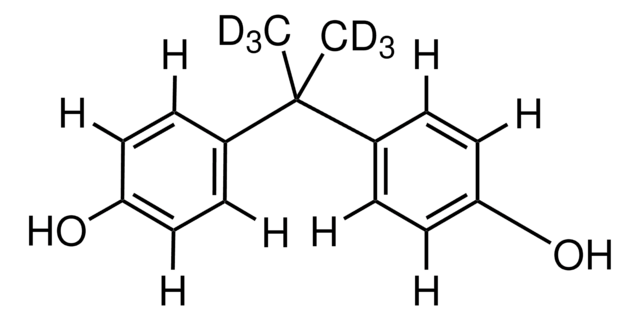If this product has an expiration or retest date, it will be shown on the Certificate of Analysis (COA, CofA). If there is no retest or expiration date listed on the product's COA, we do not have suitable stability data to determine a shelf life. For these products, the only date on the COA will be the release date; a retest, expiration, or use-by-date will not be displayed.
For all products, we recommend handling per defined conditions as printed in our product literature and website product descriptions. We recommend that products should be routinely inspected by customers to ensure they perform as expected.
For products without retest or expiration dates, our standard warranty of 1 year from the date of shipment is applicable.
For more information, please refer to the Product Dating Information document: https://www.sigmaaldrich.com/deepweb/assets/sigmaaldrich/marketing/global/documents/449/386/product-dating-information-mk.pdf
Kluczowe dokumenty
239658
Bisphenol A
≥99%
Synonim(y):
2,2-Bis(4-hydroxyphenyl)propane, 4,4′-Isopropylidenediphenol
Wybierz wielkość
364,00 zł
Wybierz wielkość
About This Item
364,00 zł
Polecane produkty
Próba
≥99%
Formularz
solid
bp
220 °C/4 mmHg (lit.)
mp
158-159 °C (lit.)
ciąg SMILES
CC(C)(c1ccc(O)cc1)c2ccc(O)cc2
InChI
1S/C15H16O2/c1-15(2,11-3-7-13(16)8-4-11)12-5-9-14(17)10-6-12/h3-10,16-17H,1-2H3
Klucz InChI
IISBACLAFKSPIT-UHFFFAOYSA-N
informacje o genach
mouse ... Esr1(13982)
rat ... Ar(24208)
Szukasz podobnych produktów? Odwiedź Przewodnik dotyczący porównywania produktów
Powiązane kategorie
Opis ogólny
Zastosowanie
- Quantitative analysis of bisphenol A and bisphenol S in three plastic product samples of a mineral water bottle, polycarbonate bottle, and baby bottle, using a modified glassy carbon electrode (GCE) sensor based on a crystalline covalent organic framework (COF)
- Simultaneous determination of bisphenol A, S, and F in 112 samples of thermal paper receipts by liquid chromatography coupled to mass spectrometry (LC-MS) following their ultrasound-assisted extraction
- Development and validation of a gas chromatography-tandem mass spectrometry (GC-MS/MS) method for the measurement of bisphenol A and 18 BPA-related compounds in 30 breast milk samples after their solid phase extraction (SPE)
- Construction of an electrochemical sensor based on multi-walled carbon nanotubes (MWCNTs) modified glassy carbon electrode (GCE) for the determination of bisphenol A & S in river water and thermal paper samples by cyclic voltammetry (CV)
- Determination of bisphenol A in urine samples using a novel method based on miniaturized QuEChERS extraction and gas chromatography-mass spectrometry (GC-MS)
- Investigate the bisphenol A content from glass or Pasteur pipettes in biological liquids from maternal women using high-performance liquid chromatography (HPLC).[1]
Hasło ostrzegawcze
Danger
Zwroty wskazujące rodzaj zagrożenia
Zwroty wskazujące środki ostrożności
Klasyfikacja zagrożeń
Aquatic Acute 1 - Aquatic Chronic 1 - Eye Dam. 1 - Repr. 1B - Skin Sens. 1 - STOT SE 3
Organy docelowe
Respiratory system
Kod klasy składowania
6.1C - Combustible acute toxic Cat.3 / toxic compounds or compounds which causing chronic effects
Klasa zagrożenia wodnego (WGK)
WGK 3
Temperatura zapłonu (°F)
440.6 °F - closed cup
Temperatura zapłonu (°C)
227 °C - closed cup
Środki ochrony indywidualnej
Eyeshields, Faceshields, Gloves, type P3 (EN 143) respirator cartridges
Wykazy regulacyjne
Wykazy regulacyjne dotyczą głównie produktów chemicznych. Można w nich podawać ograniczoną liczbę informacji na temat produktów niechemicznych. Brak wpisu oznacza, że żaden ze składników nie znajduje się w wykazie. Użytkownik odpowiada za zagwarantowanie bezpiecznego i zgodnego z prawem stosowania produktu.
EU REACH SVHC Candidate List
EU REACH Annex XVII (Restriction List)
Wybierz jedną z najnowszych wersji:
Masz już ten produkt?
Dokumenty związane z niedawno zakupionymi produktami zostały zamieszczone w Bibliotece dokumentów.
Klienci oglądali również te produkty
Protokoły
A comprehensive sample preparation and analytical procedure was developed by Supelco for determining BPA in drinking water.
Firma Supelco opracowała kompleksową procedurę przygotowania i analizy próbek do oznaczania BPA w wodzie pitnej.
-
How can I determine the shelf life / expiration / retest date of this product?
1 answer-
Helpful?
-
-
How is shipping temperature determined? And how is it related to the product storage temperature?
1 answer-
Products may be shipped at a different temperature than the recommended long-term storage temperature. If the product quality is sensitive to short-term exposure to conditions other than the recommended long-term storage, it will be shipped on wet or dry-ice. If the product quality is NOT affected by short-term exposure to conditions other than the recommended long-term storage, it will be shipped at ambient temperature. As shipping routes are configured for minimum transit times, shipping at ambient temperature helps control shipping costs for our customers. For more information, please refer to the Storage and Transport Conditions document: https://www.sigmaaldrich.com/deepweb/assets/sigmaaldrich/marketing/global/documents/316/622/storage-transport-conditions-mk.pdf
Helpful?
-
-
Does BPA dissolve in oils? such as corn oil or olive oil ?
1 answer-
This product is not tested for solubility in corn or olive oil. The solubility of this material in oils would have to be determined by the end-user. However, see the link below to a publication that indicates that may be soluble. This information has not been verified.
https://pubmed.ncbi.nlm.nih.gov/35342727/Helpful?
-
Active Filters
Nasz zespół naukowców ma doświadczenie we wszystkich obszarach badań, w tym w naukach przyrodniczych, materiałoznawstwie, syntezie chemicznej, chromatografii, analityce i wielu innych dziedzinach.
Skontaktuj się z zespołem ds. pomocy technicznej












